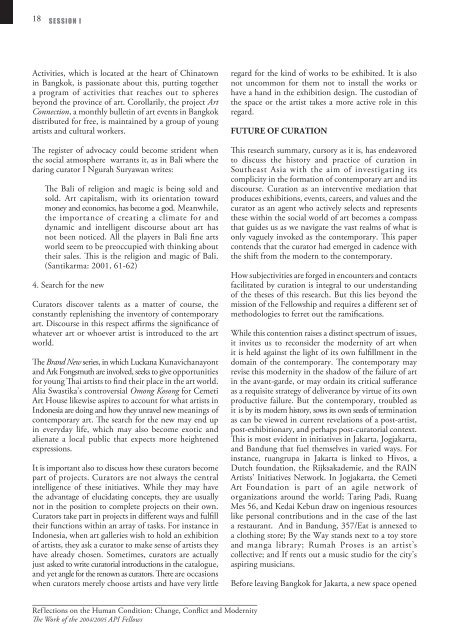Reflections on the Human Condition - Api-fellowships.org
Reflections on the Human Condition - Api-fellowships.org
Reflections on the Human Condition - Api-fellowships.org
You also want an ePaper? Increase the reach of your titles
YUMPU automatically turns print PDFs into web optimized ePapers that Google loves.
18<br />
SESSION I<br />
Activities, which is located at <strong>the</strong> heart of Chinatown<br />
in Bangkok, is passi<strong>on</strong>ate about this, putting toge<strong>the</strong>r<br />
a program of activities that reaches out to spheres<br />
bey<strong>on</strong>d <strong>the</strong> province of art. Corollarily, <strong>the</strong> project Art<br />
C<strong>on</strong>necti<strong>on</strong>, a m<strong>on</strong>thly bulletin of art events in Bangkok<br />
distributed for free, is maintained by a group of young<br />
artists and cultural workers.<br />
The register of advocacy could become strident when<br />
<strong>the</strong> social atmosphere warrants it, as in Bali where <strong>the</strong><br />
daring curator I Ngurah Suryawan writes:<br />
The Bali of religi<strong>on</strong> and magic is being sold and<br />
sold. Art capitalism, with its orientati<strong>on</strong> toward<br />
m<strong>on</strong>ey and ec<strong>on</strong>omics, has become a god. Meanwhile,<br />
<strong>the</strong> importance of creating a climate for and<br />
dynamic and intelligent discourse about art has<br />
not been noticed. All <strong>the</strong> players in Bali fine arts<br />
world seem to be preoccupied with thinking about<br />
<strong>the</strong>ir sales. This is <strong>the</strong> religi<strong>on</strong> and magic of Bali.<br />
(Santikarma: 2001, 61-62)<br />
4. Search for <strong>the</strong> new<br />
Curators discover talents as a matter of course, <strong>the</strong><br />
c<strong>on</strong>stantly replenishing <strong>the</strong> inventory of c<strong>on</strong>temporary<br />
art. Discourse in this respect affirms <strong>the</strong> significance of<br />
whatever art or whoever artist is introduced to <strong>the</strong> art<br />
world.<br />
The Brand New series, in which Luckana Kunavichanay<strong>on</strong>t<br />
and Ark F<strong>on</strong>gsmuth are involved, seeks to give opportunities<br />
for young Thai artists to find <strong>the</strong>ir place in <strong>the</strong> art world.<br />
Alia Swastika’s c<strong>on</strong>troversial Om<strong>on</strong>g Kos<strong>on</strong>g for Cemeti<br />
Art House likewise aspires to account for what artists in<br />
Ind<strong>on</strong>esia are doing and how <strong>the</strong>y unravel new meanings of<br />
c<strong>on</strong>temporary art. The search for <strong>the</strong> new may end up<br />
in everyday life, which may also become exotic and<br />
alienate a local public that expects more heightened<br />
expressi<strong>on</strong>s.<br />
It is important also to discuss how <strong>the</strong>se curators become<br />
part of projects. Curators are not always <strong>the</strong> central<br />
intelligence of <strong>the</strong>se initiatives. While <strong>the</strong>y may have<br />
<strong>the</strong> advantage of elucidating c<strong>on</strong>cepts, <strong>the</strong>y are usually<br />
not in <strong>the</strong> positi<strong>on</strong> to complete projects <strong>on</strong> <strong>the</strong>ir own.<br />
Curators take part in projects in different ways and fulfill<br />
<strong>the</strong>ir functi<strong>on</strong>s within an array of tasks. For instance in<br />
Ind<strong>on</strong>esia, when art galleries wish to hold an exhibiti<strong>on</strong><br />
of artists, <strong>the</strong>y ask a curator to make sense of artists <strong>the</strong>y<br />
have already chosen. Sometimes, curators are actually<br />
just asked to write curatorial introducti<strong>on</strong>s in <strong>the</strong> catalogue,<br />
and yet angle for <strong>the</strong> renown as curators. There are occasi<strong>on</strong>s<br />
when curators merely choose artists and have very little<br />
Ref lecti<strong>on</strong>s <strong>on</strong> <strong>the</strong> <strong>Human</strong> C<strong>on</strong>diti<strong>on</strong>: Change, C<strong>on</strong>flict and Modernity<br />
The Work of <strong>the</strong> 2004/2005 API Fellows<br />
regard for <strong>the</strong> kind of works to be exhibited. It is also<br />
not uncomm<strong>on</strong> for <strong>the</strong>m not to install <strong>the</strong> works or<br />
have a hand in <strong>the</strong> exhibiti<strong>on</strong> design. The custodian of<br />
<strong>the</strong> space or <strong>the</strong> artist takes a more active role in this<br />
regard.<br />
FUTURE OF CURATION<br />
This research summary, cursory as it is, has endeavored<br />
to discuss <strong>the</strong> history and practice of curati<strong>on</strong> in<br />
Sou<strong>the</strong>ast Asia with <strong>the</strong> aim of investigating its<br />
complicity in <strong>the</strong> formati<strong>on</strong> of c<strong>on</strong>temporary art and its<br />
discourse. Curati<strong>on</strong> as an interventive mediati<strong>on</strong> that<br />
produces exhibiti<strong>on</strong>s, events, careers, and values and <strong>the</strong><br />
curator as an agent who actively selects and represents<br />
<strong>the</strong>se within <strong>the</strong> social world of art becomes a compass<br />
that guides us as we navigate <strong>the</strong> vast realms of what is<br />
<strong>on</strong>ly vaguely invoked as <strong>the</strong> c<strong>on</strong>temporary. This paper<br />
c<strong>on</strong>tends that <strong>the</strong> curator had emerged in cadence with<br />
<strong>the</strong> shift from <strong>the</strong> modern to <strong>the</strong> c<strong>on</strong>temporary.<br />
How subjectivities are f<strong>org</strong>ed in encounters and c<strong>on</strong>tacts<br />
facilitated by curati<strong>on</strong> is integral to our understanding<br />
of <strong>the</strong> <strong>the</strong>ses of this research. But this lies bey<strong>on</strong>d <strong>the</strong><br />
missi<strong>on</strong> of <strong>the</strong> Fellowship and requires a different set of<br />
methodologies to ferret out <strong>the</strong> ramificati<strong>on</strong>s.<br />
While this c<strong>on</strong>tenti<strong>on</strong> raises a distinct spectrum of issues,<br />
it invites us to rec<strong>on</strong>sider <strong>the</strong> modernity of art when<br />
it is held against <strong>the</strong> light of its own fulfillment in <strong>the</strong><br />
domain of <strong>the</strong> c<strong>on</strong>temporary. The c<strong>on</strong>temporary may<br />
revise this modernity in <strong>the</strong> shadow of <strong>the</strong> failure of art<br />
in <strong>the</strong> avant-garde, or may ordain its critical sufferance<br />
as a requisite strategy of deliverance by virtue of its own<br />
productive failure. But <strong>the</strong> c<strong>on</strong>temporary, troubled as<br />
it is by its modern history, sows its own seeds of terminati<strong>on</strong><br />
as can be viewed in current revelati<strong>on</strong>s of a post-artist,<br />
post-exhibiti<strong>on</strong>ary, and perhaps post-curatorial c<strong>on</strong>text.<br />
This is most evident in initiatives in Jakarta, Jogjakarta,<br />
and Bandung that fuel <strong>the</strong>mselves in varied ways. For<br />
instance, ruangrupa in Jakarta is linked to Hivos, a<br />
Dutch foundati<strong>on</strong>, <strong>the</strong> Rijksakademie, and <strong>the</strong> RAIN<br />
Artists’ Initiatives Network. In Jogjakarta, <strong>the</strong> Cemeti<br />
Art Foundati<strong>on</strong> is part of an agile network of<br />
<strong>org</strong>anizati<strong>on</strong>s around <strong>the</strong> world; Taring Padi, Ruang<br />
Mes 56, and Kedai Kebun draw <strong>on</strong> ingenious resources<br />
like pers<strong>on</strong>al c<strong>on</strong>tributi<strong>on</strong>s and in <strong>the</strong> case of <strong>the</strong> last<br />
a restaurant. And in Bandung, 357/Eat is annexed to<br />
a clothing store; By <strong>the</strong> Way stands next to a toy store<br />
and manga library; Rumah Proses is an artist’s<br />
collective; and If rents out a music studio for <strong>the</strong> city’s<br />
aspiring musicians.<br />
Before leaving Bangkok for Jakarta, a new space opened

















